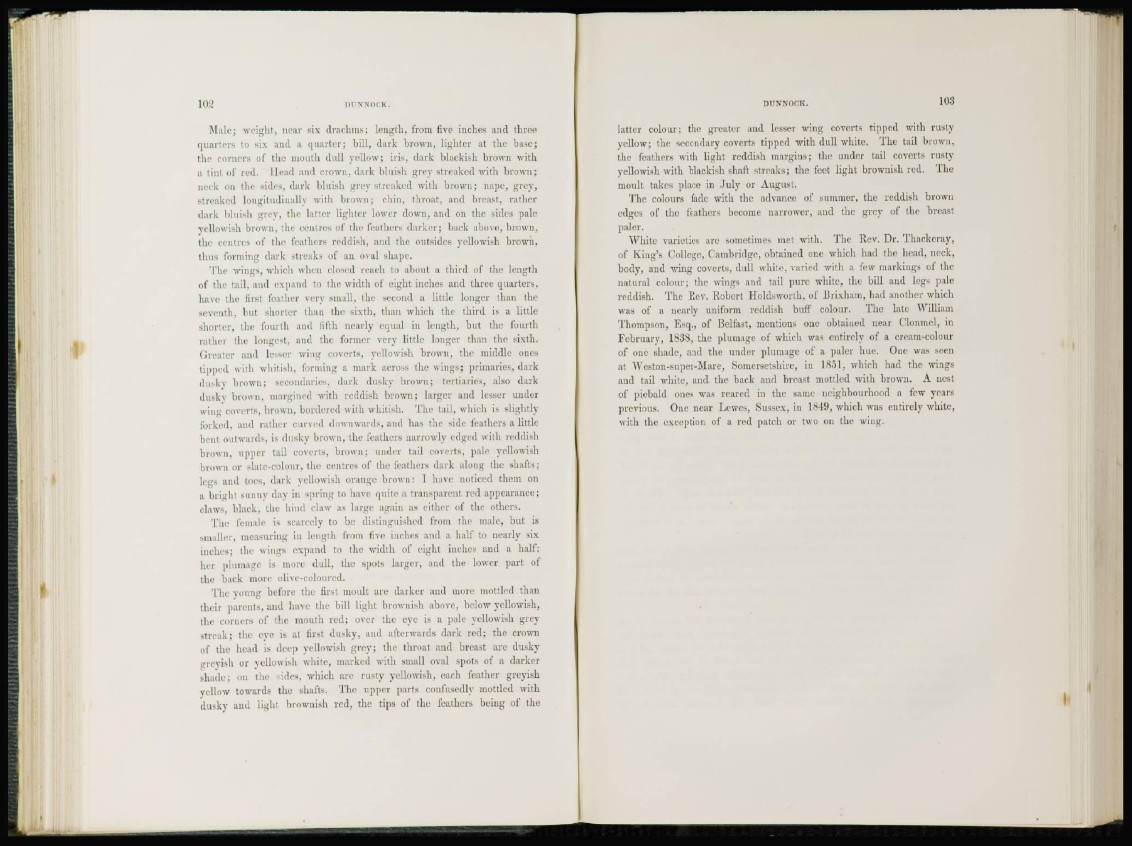
Male; weight, near six drachms; length, from five inches and three
quarters to six and a quarter; bill, dark brown, lighter at the base;
the comers of the mouth dull yellow; iris, dark blackish brown with
a tint of red. Head and crown, dark bluish grey streaked with brown;
neck (m the sides, dark bluish grey streaked with brown; nape, grey,
streaked longitudinally with brown; chin, throat, and breast, rather
dark bluish grey, the latter lighter lower down, and on the sides pale
yellowish brown, the centres of (he feathers darker; back above, brown,
the centx'es of the feathers reddish, and the outsides yellowish brown,
thus forming dark streaks of an oval shape.
The wings, which when closed reach to about a third of the length
of the tail, and expand to the width ot' eight inches and three quarters,
have the first feather very small, the second a little longer than the
seventh, but shorter than the sixth, than which the third is a little
shorter, the fourth and fifth nearly equal in length, but the fourth
rather the longest, and the former very little longer than the sixth.
Greater and lesser wing coverts, yellowish brown, the middle ones
tipped with whitish, forming a mark across the wings; primaries, dark
dusk) brown; secondaries, dark dusky brown; tortiaries, also dark
dusky brown, margined with reddish brown; larger and lesser under
wing coverts, brown, bordered with whitish. The tail, which is slightly
forked, and rather curved downwards, and has the side feathers a little
bent outwards, is dusky brown, the leathers narrowly edged with reddish
brown, upper tail coverts, brown; under tail coverts, pale yellowish
brown or slate-colour, the centres of the feathers dark along the shafts;
legs and toes, dark yellowish orange brown: I have noticed them on
a blight sunny day in spring to have quite a transparent red appearance;
claws, black, the hind claw as large again as either of the others.
The female is scarcely (o be distinguished from the male, but is
smaller, measuring in length from five inches and a half to nearly six
inches; the wings expand to the width of eight inches and a half:
her plumage is more dull, the spots larger, and the lower part of
the hack more olive-coloured.
The young before the first moult are darker and more mottled than
their parents, and have the bill light brownish above, below yellowish,
the corners of the mouth red; over the eye is a pale yellowish grey
streak; the eye is at firsl dusky, and afterwards dark red; the crown
of the head is deep yellowish grey; the throat and breast arc dusky
greyish or yellowish white, marked with small oval spots of a darker
shade; on the sides, which are rusty yellowish, each feather greyish
yellow towards the shafts. The upper parts confusedly mottled with
dusky and light brownish red, the tips of the feathers being of the
latter colour; the greater and lesser wing coverts tipped with rusty
yellow; the secondary coverts tipped with dull white. The tail brown,
the feathers with light reddish margins; the under tail coverts rusty
yellowish with blackish shaft streaks; the feet light brownish red. The
moult takes place in July or August.
The colours fade with the advance of summer, the reddish brown
edges of the feathers become narrower, and the grey of the breast
paler.
White varieties are sometimes met with. The Rev. Dr. Thackeray,
of King's College, Cambridge, obtained one which had the head, neck,
body, and wing coverts, dull white, varied with a few markings of the
natural colour; the wings and tail pure white, the bill and legs pale
reddish. The Rev. Robert Holdsworth, of Brixham, had another which
was of a nearly uniform reddish buff colour. The late William
Thompson, Esq., of Belfast, mentions one obtained near Clonmel, in
February, 1838, the plumage of which was entirely of a cream-colour
of one shade, and the under plumage of a paler hue. One was seen
at Weston-super-Mare, Somersetshire, in 1851, which had the wings
and tail white, and the back and breast mottled with brown. A nest
of piebald ones was reared in the same neighbourhood a few years
previous. One near Lewes, Sussex, in 18-19, which was entirely white,
with the exception of a red patch or two on the wing.